
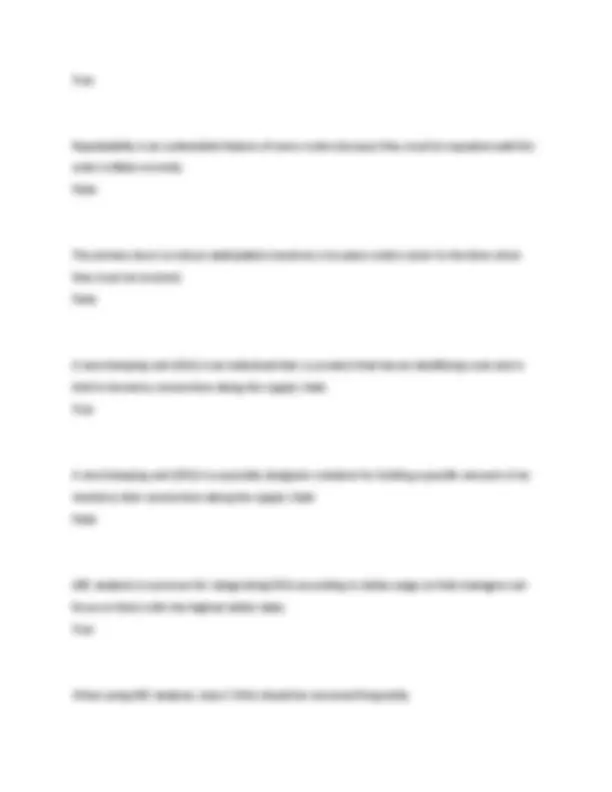
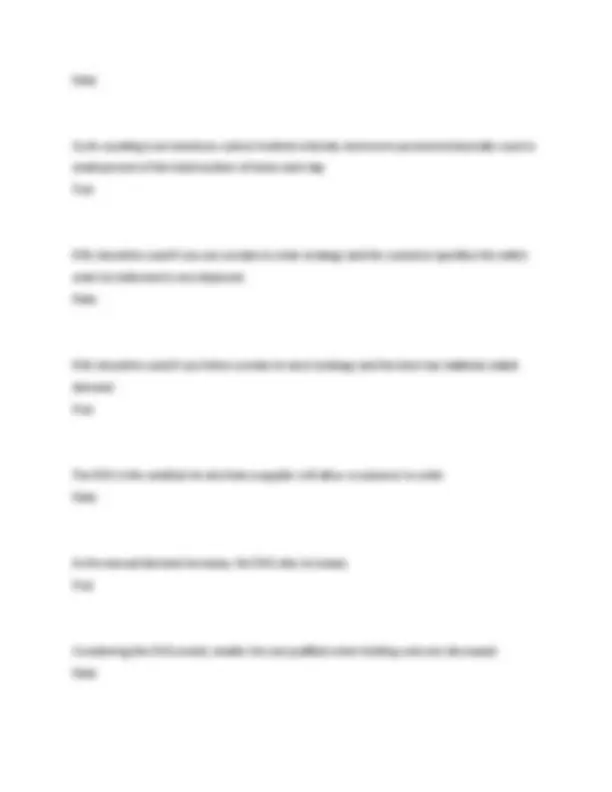
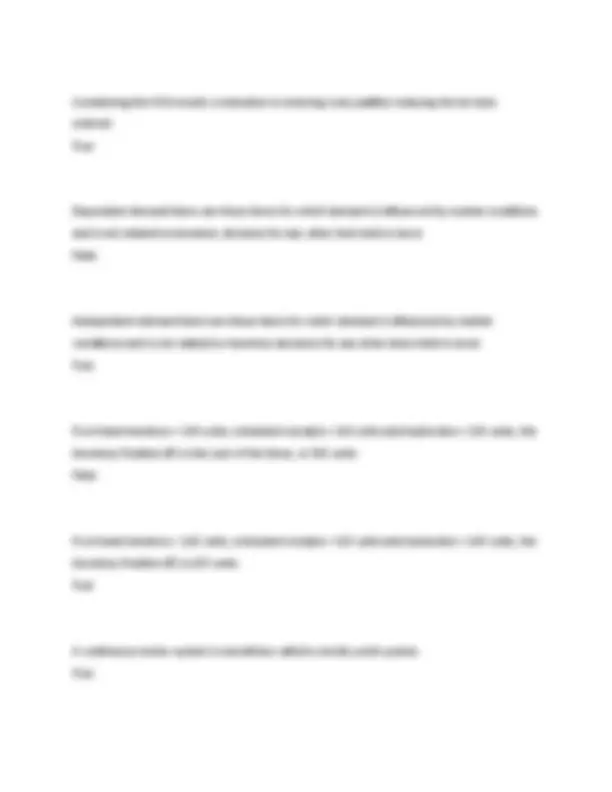
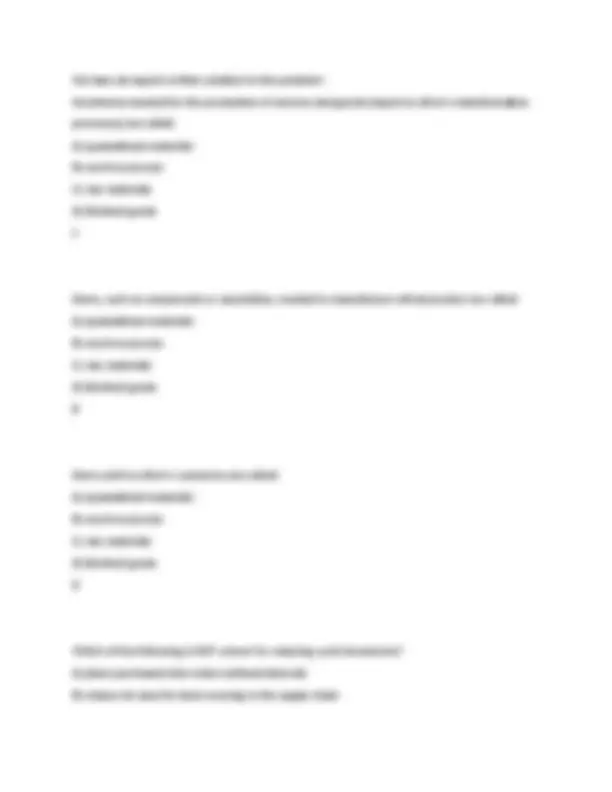
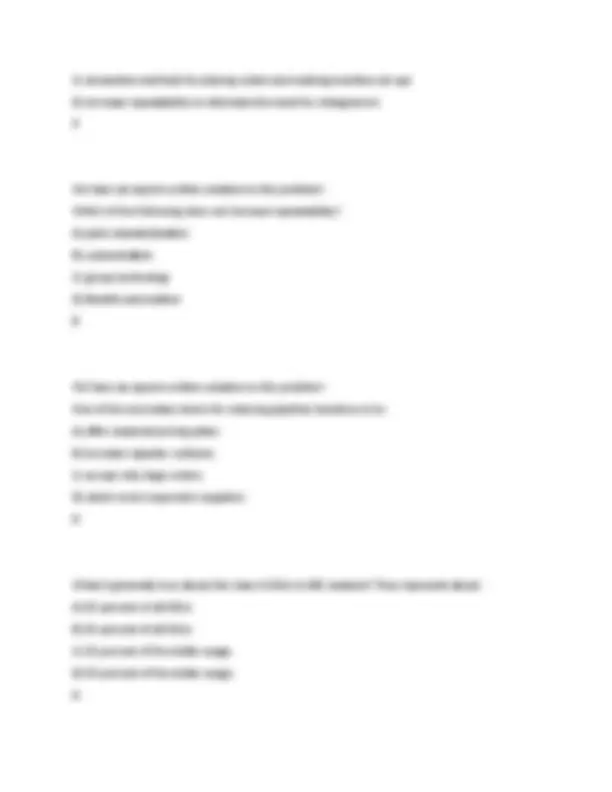
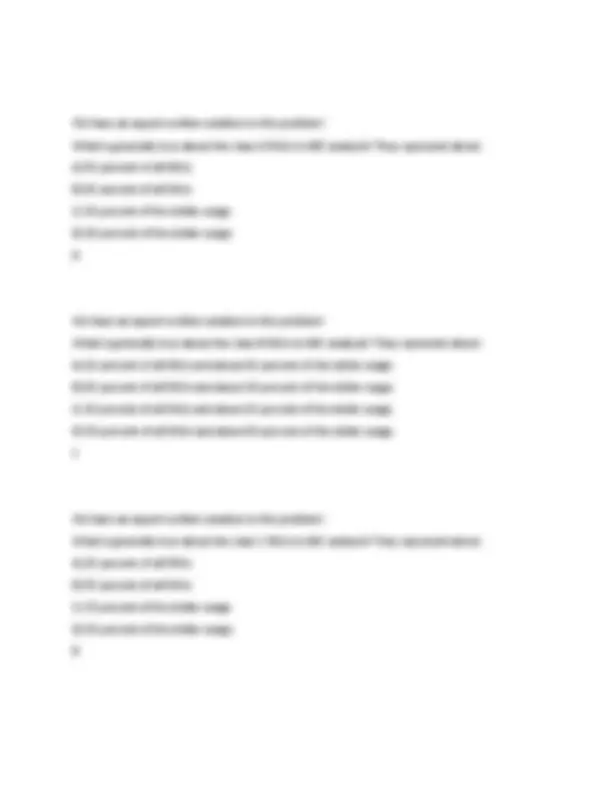
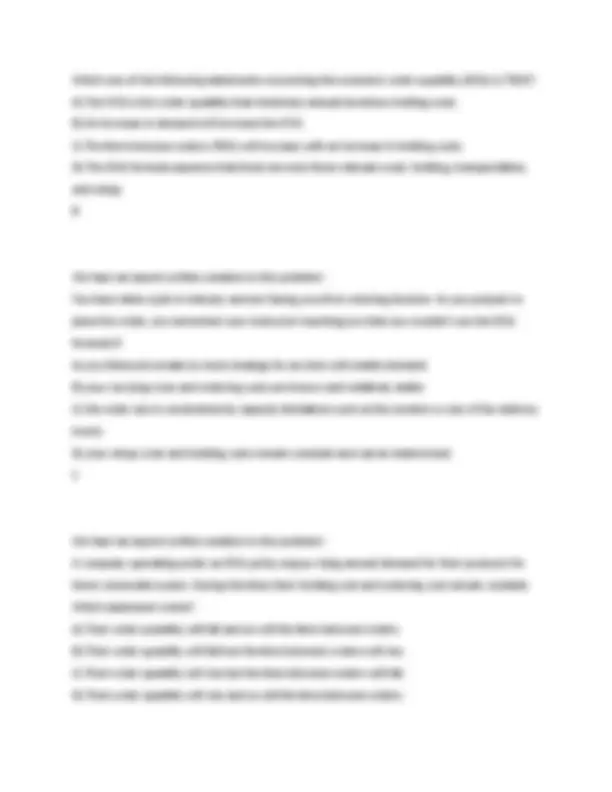
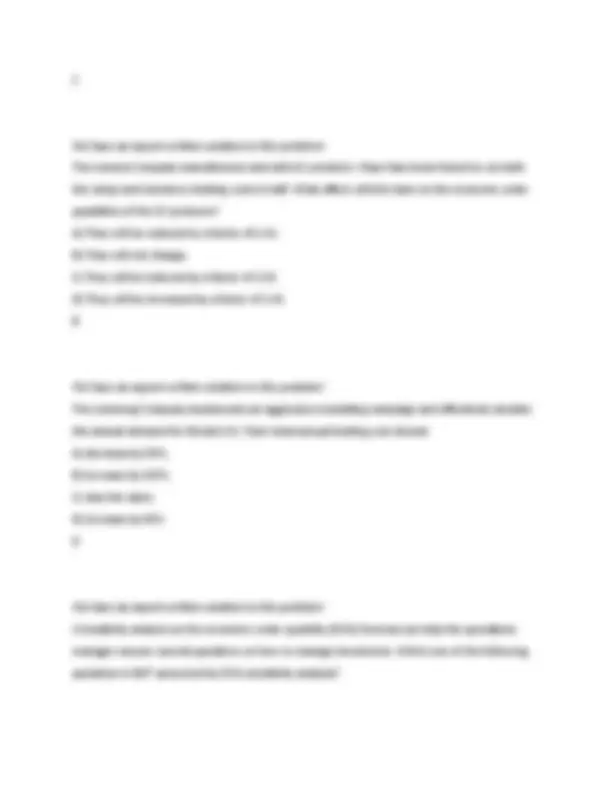
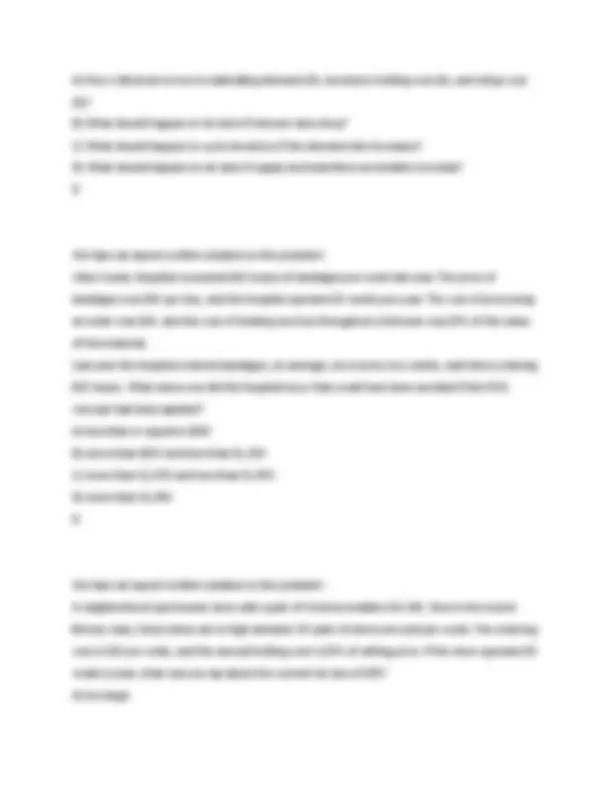
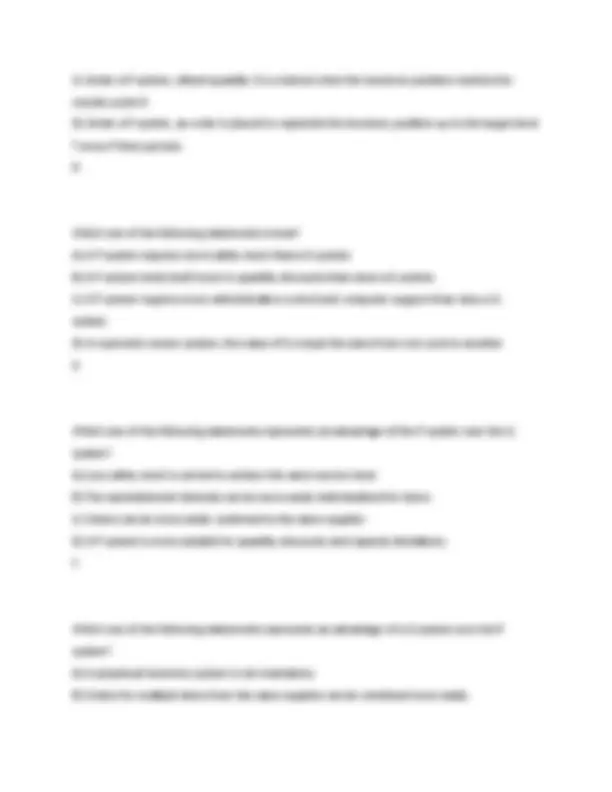
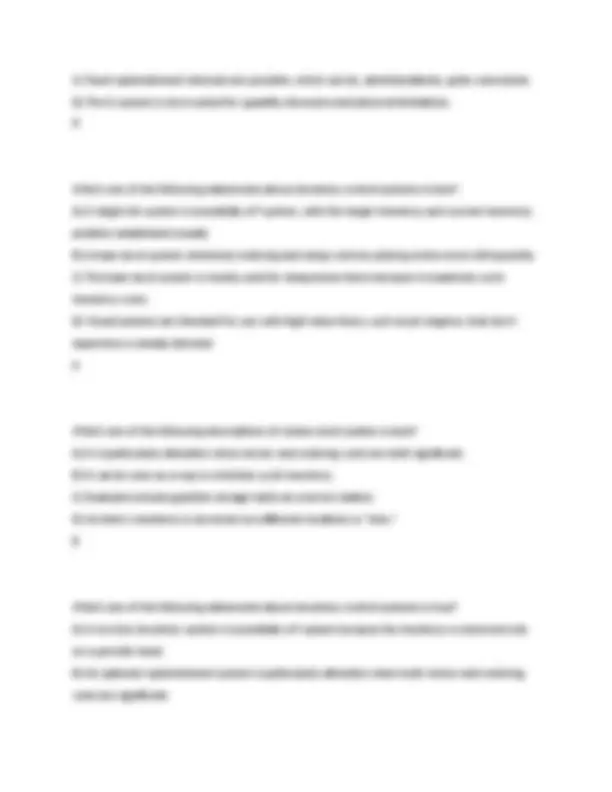
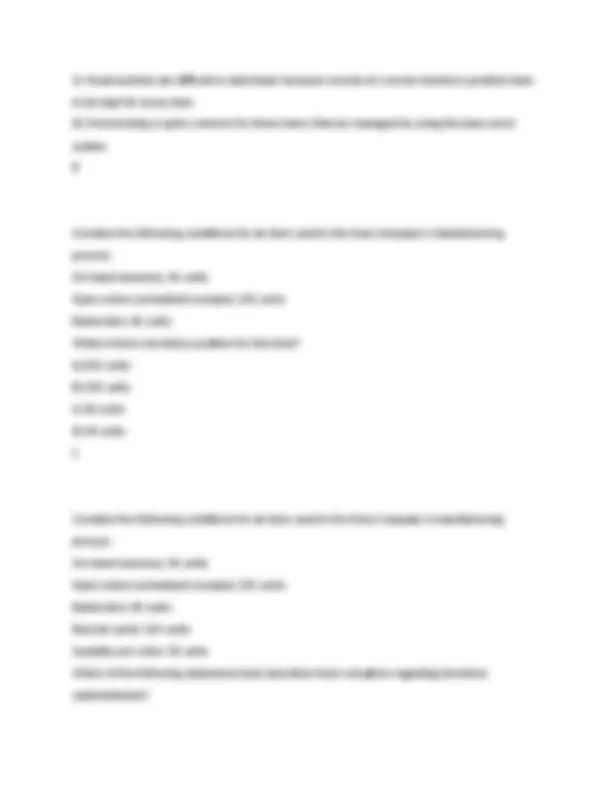
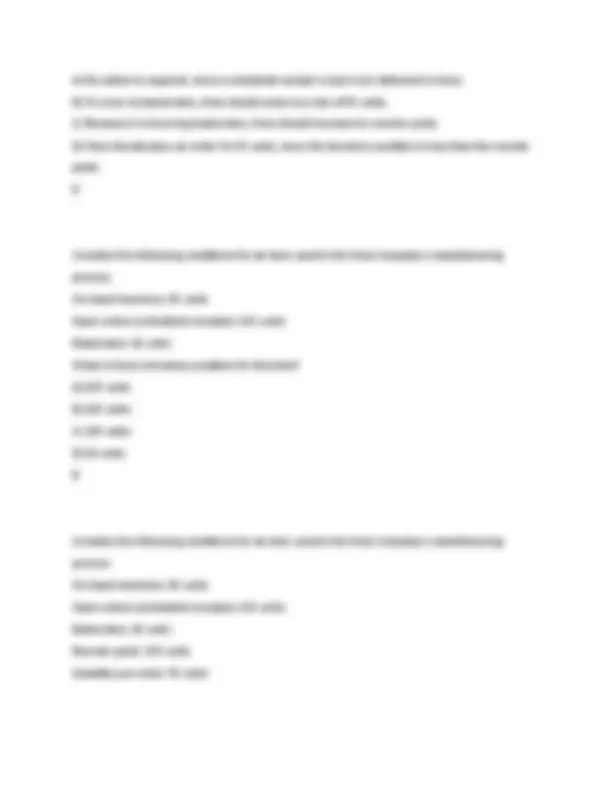
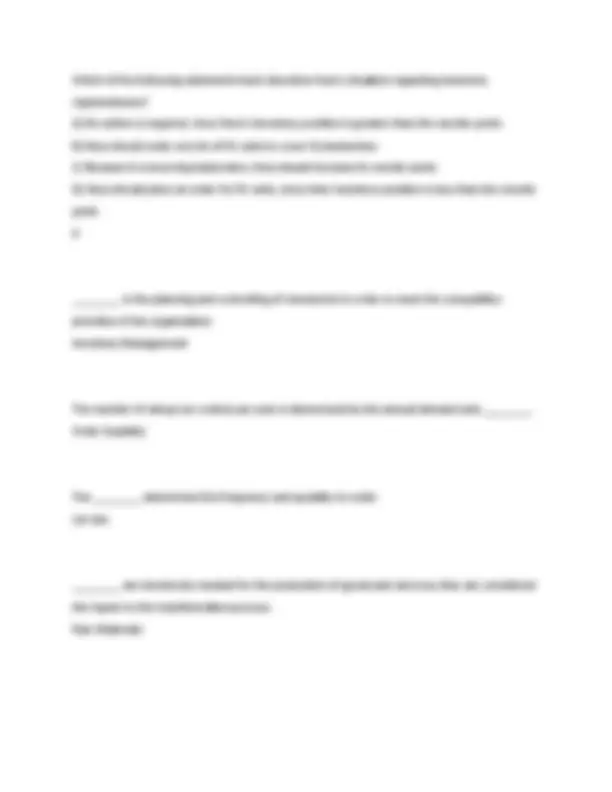
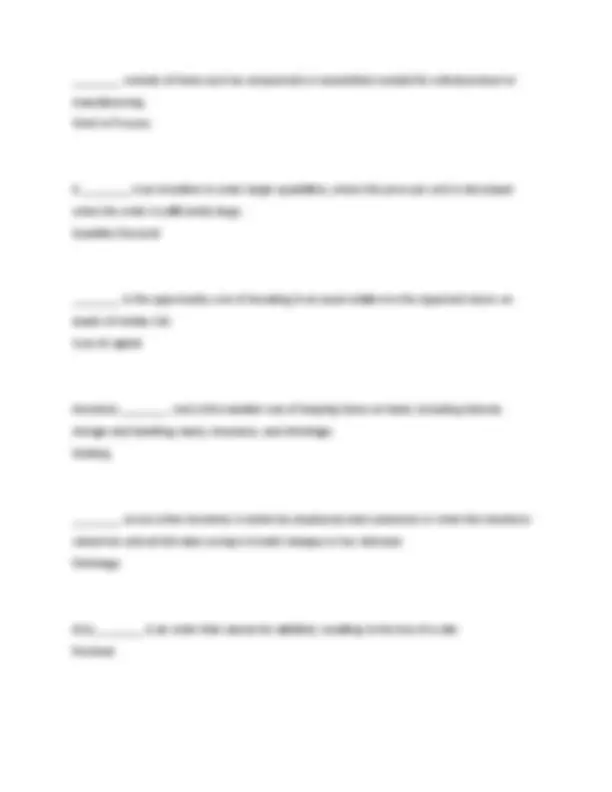
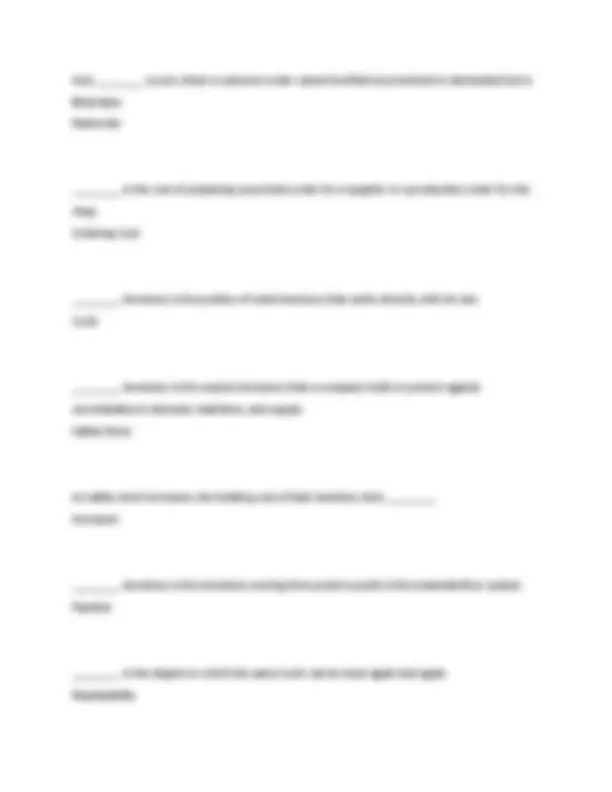
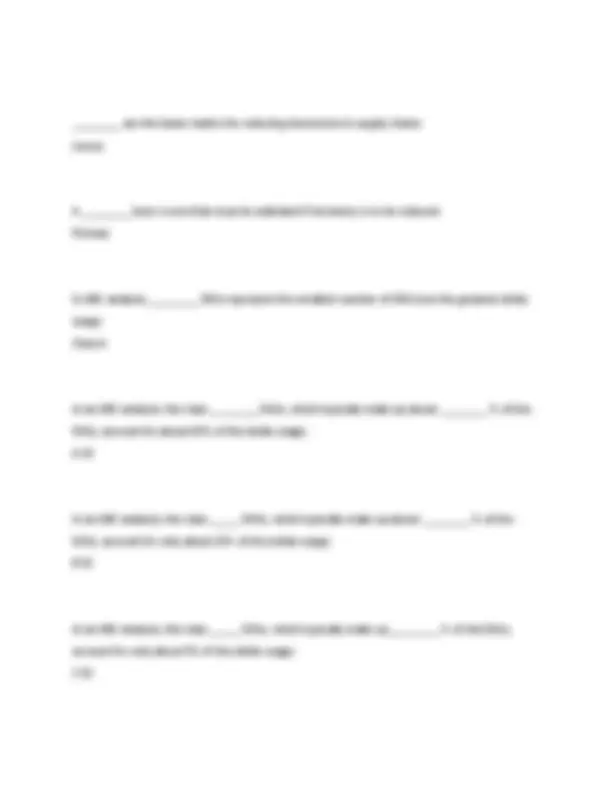
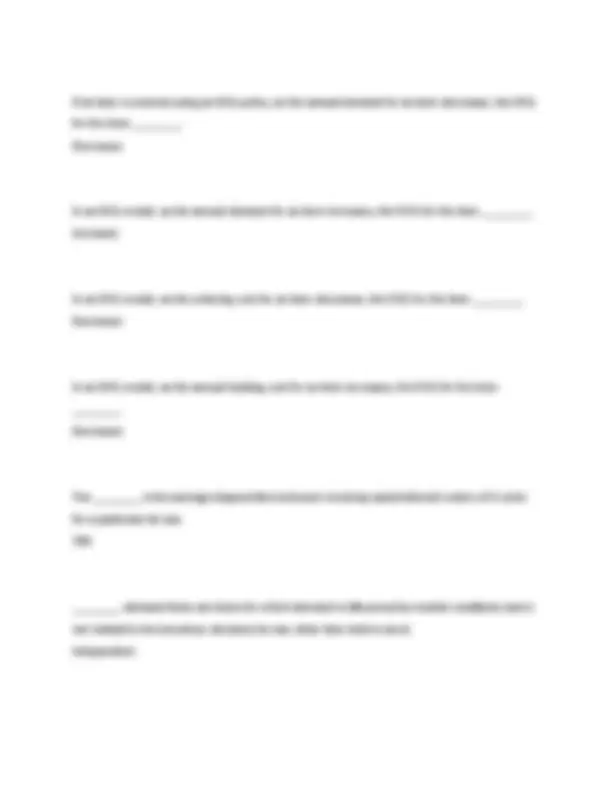
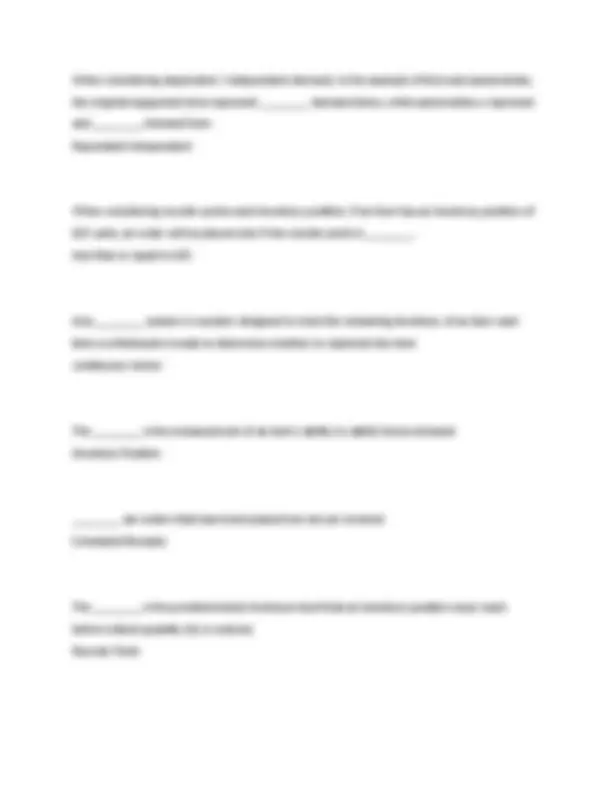
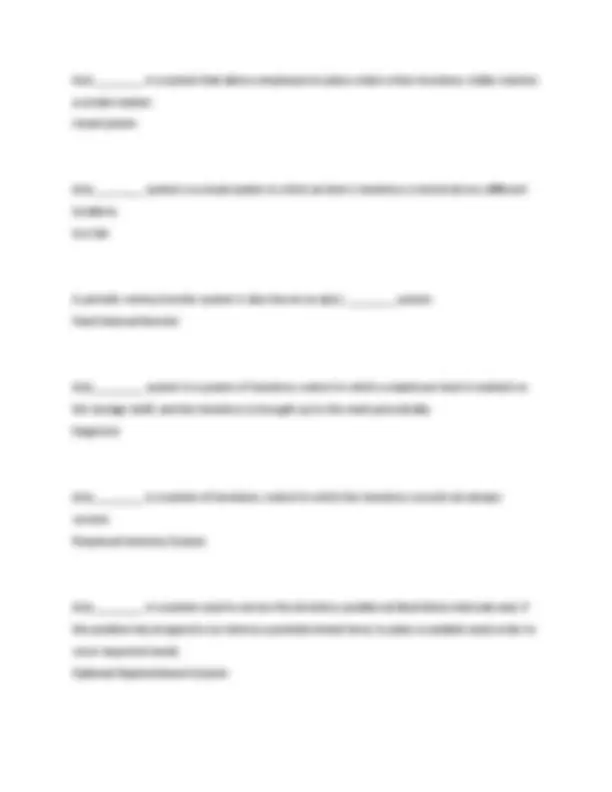
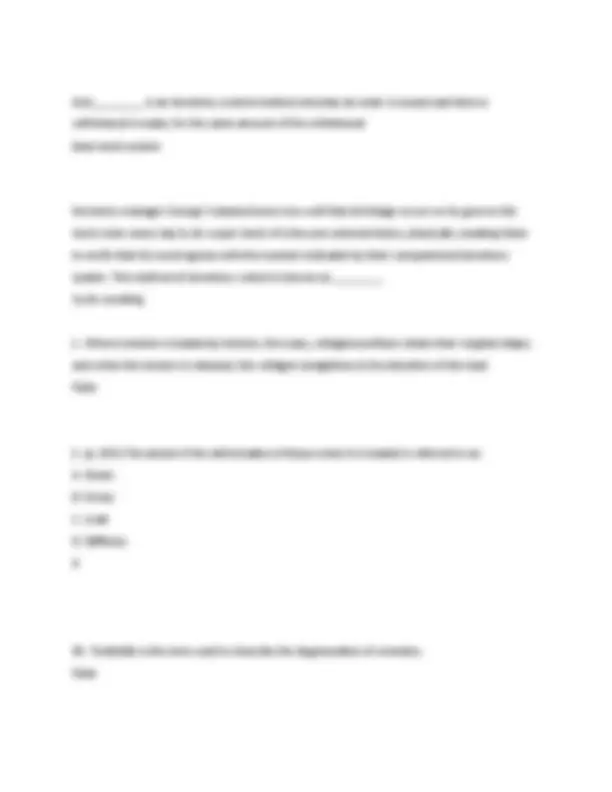
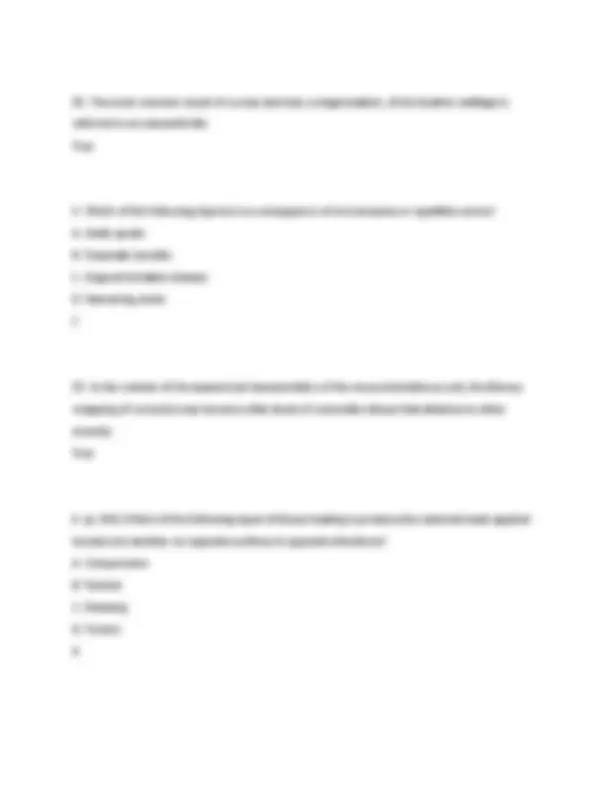
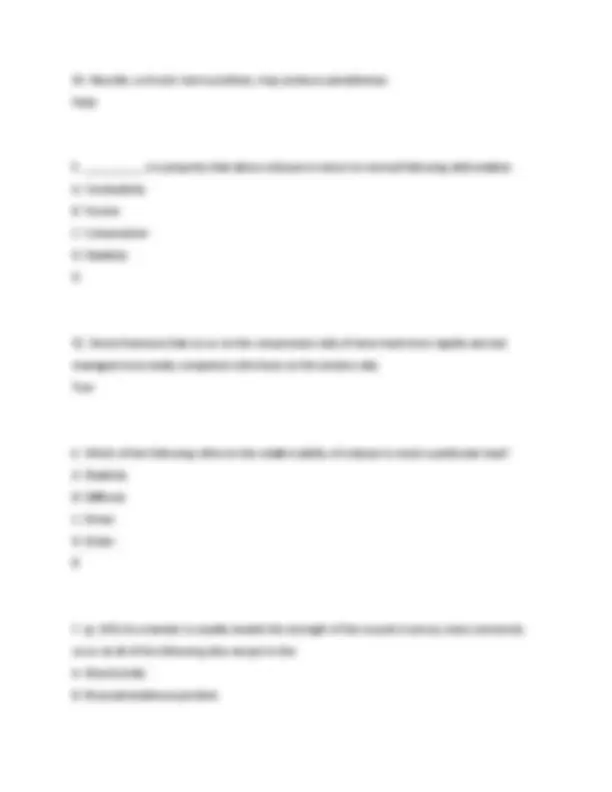
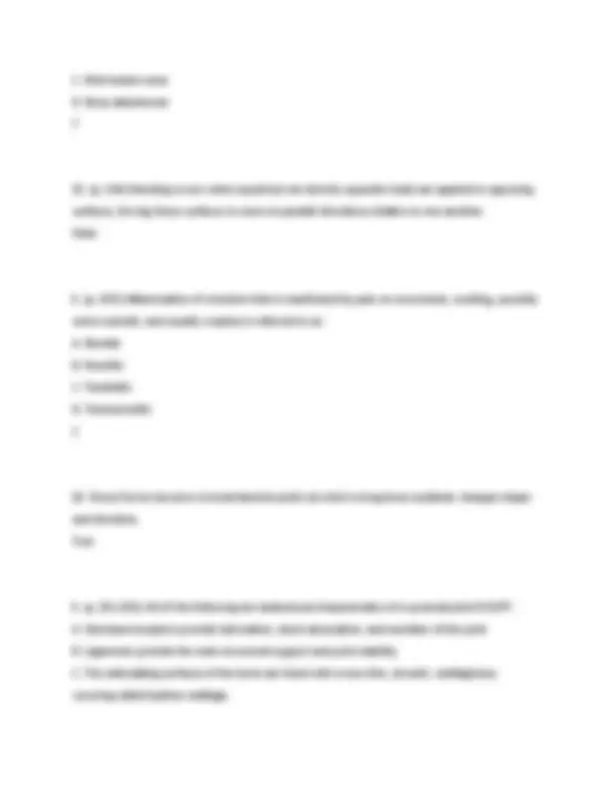
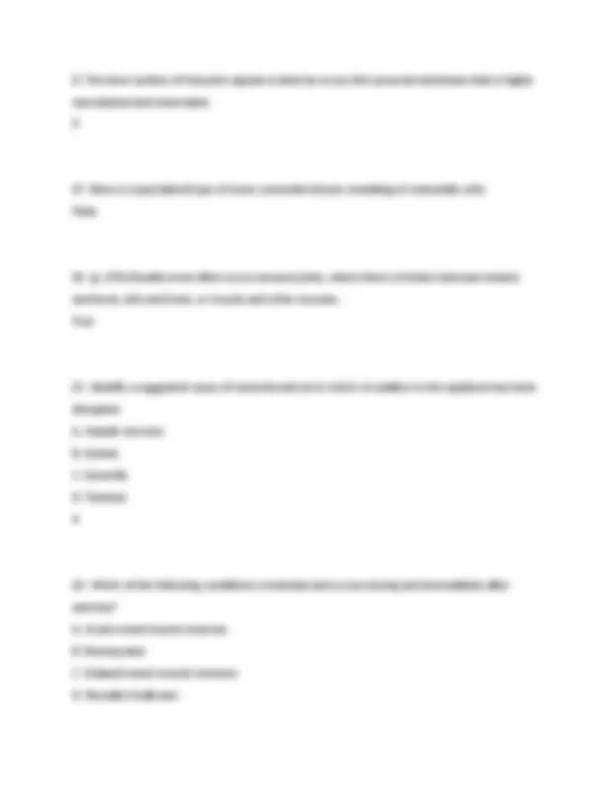

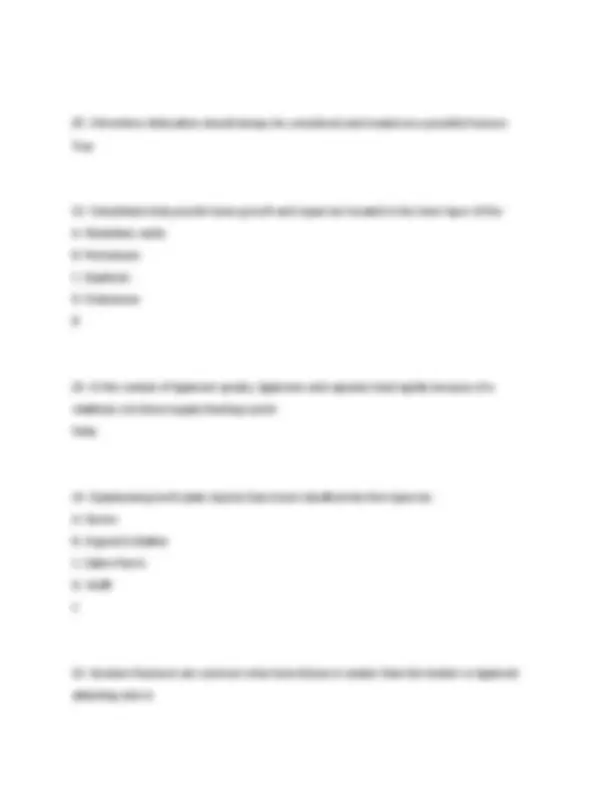
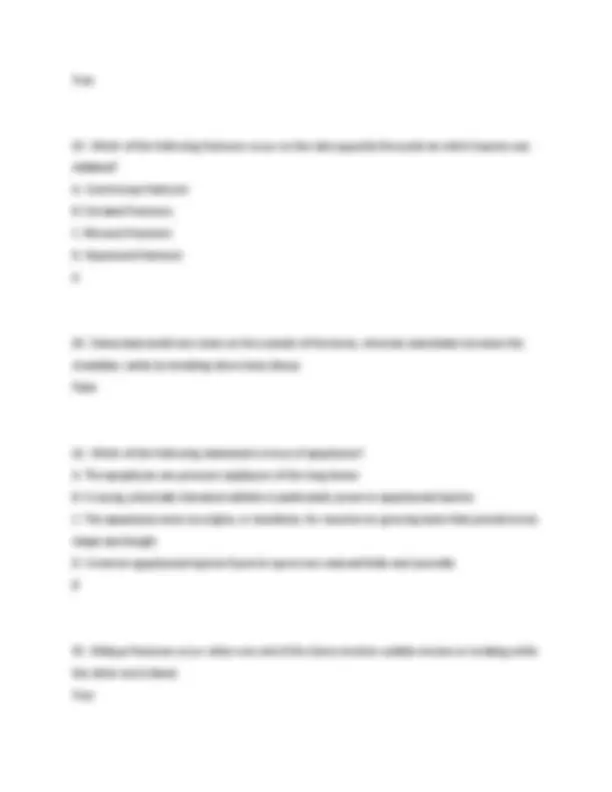
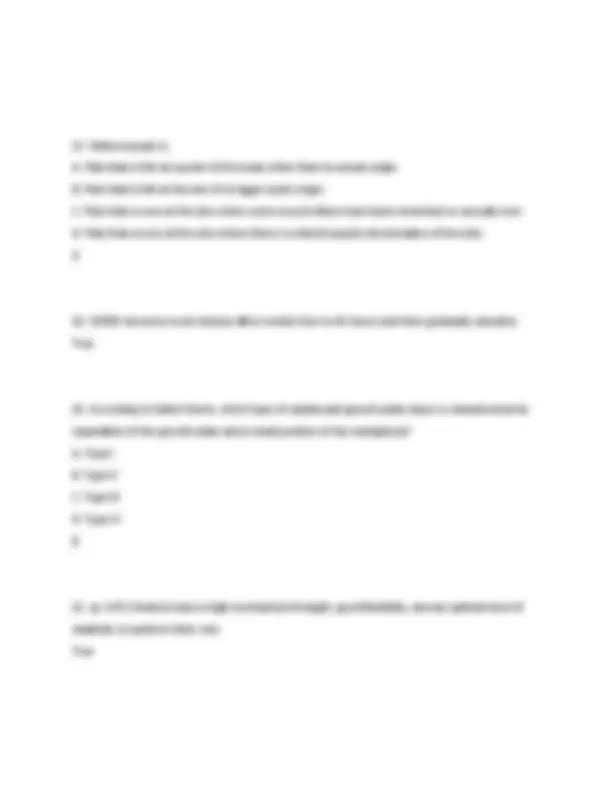


Study with the several resources on Docsity

Earn points by helping other students or get them with a premium plan


Prepare for your exams
Study with the several resources on Docsity

Earn points to download
Earn points by helping other students or get them with a premium plan
Community
Ask the community for help and clear up your study doubts
Discover the best universities in your country according to Docsity users
Free resources
Download our free guides on studying techniques, anxiety management strategies, and thesis advice from Docsity tutors
Test Bank Ignatavicius Medical Surgical 9th Edition [ALL CHAPTERS ANSWERED WITH RATIONALES] Inventory management is the planning and controlling of inventories in order to meet the competitive priorities of the organization. True When looking at inventory management, the term "lot size" refers to the physical dimensions of the area where the inventory is stored. False
Typology: Exams
1 / 37

This page cannot be seen from the preview
Don't miss anything!






























Inventory management is the planning and controlling of inventories in order to meet the competitive priorities of the organization. True When looking at inventory management, the term "lot size" refers to the physical dimensions of the area where the inventory is stored. False When looking at inventory management, the term "lot size" refers to the quantity of an inventory item management either buys from a supplier or manufactures using internal processes. True The primary reason for keeping inventories low is that inventory represents a temporary monetary investment in goods on which a firm must pay interest. True One component of the holding cost of inventory is interest. True
One component of the ordering cost of inventory is shrinkage. False A stockout occurs when an item that is typically stocked is not available to satisfy a demand the moment it occurs. True A backorder occurs when a customer order cannot be filled when it is placed, but is instead filled later. True Setup cost is independent of order size True Reducing setup costs will increase the pressure to keep larger inventories. False Increasing inventory levels can sometimes help a firm reduce both its inbound and outbound transportation costs. True A quantity discount is attractive because there is a drop in the price per unit when the order is sufficiently large.
False Cycle counting is an inventory-control method whereby storeroom personnel physically count a small percent of the total number of items each day. True EOQ should be used if you use a make-to-order strategy and the customer specifies the entire order be delivered in one shipment. False EOQ should be used if you follow a make-to-stock strategy and the item has relatively stable demand. True The EOQ is the smallest lot size that a supplier will allow a customer to order. False As the annual demand increases, the EOQ also increases. True Considering the EOQ model, smaller lots are justified when holding costs are decreased. False
Considering the EOQ model, a reduction in ordering costs justifies reducing the lot sizes ordered. True Dependent demand items are those items for which demand is influenced by market conditions and is not related to inventory decisions for any other item held in stock. False Independent-demand items are those items for which demand is influenced by market conditions and is not related to inventory decisions for any other items held in stock. True If on-hand inventory = 100 units, scheduled receipts = 100 units and backorders = 100 units, the Inventory Position (IP) is the sum of the three, or 300 units. False If on-hand inventory = 100 units, scheduled receipts = 100 units and backorders = 100 units, the Inventory Position (IP) is 100 units. True A continuous review system is sometimes called a reorder point system. True
We have an expert-written solution to this problem! Which of the following generates pressure to decrease inventories? A) inventory shrinkage costs B) backorders and stockouts C) transportation costs D) quantity discounts A We have an expert-written solution to this problem! Which of the following DOES NOT generate pressure to decrease inventories? A) taxes and insurance B) inventory holding costs C) storage and handling costs D) ordering costs D We have an expert-written solution to this problem! Which of the following DOES NOT generate pressure to increase inventories? A) transportation costs B) backorders and stockouts C) inventory shrinkage costs D) quantity discounts A
We have an expert-written solution to this problem! Inventories needed for the production of services and goods (inputs to a firm's transformation processes) are called: A) quarantined materials B) work-in-process C) raw materials D) finished goods C Items, such as components or assemblies, needed to manufacture a final product are called: A) quarantined materials B) work-in-process C) raw materials D) finished goods B Items sold to a firm's customers are called: A) quarantined materials B) work-in-process C) raw materials D) finished goods D Which of the following is NOT a lever for reducing cycle inventories? A) place purchased item orders at fixed intervals B) reduce lot sizes for items moving in the supply chain
We have an expert-written solution to this problem! What is generally true about the class A SKUs in ABC analysis? They represent about: A) 50 percent of all SKUs. B) 80 percent of all SKUs. C) 20 percent of the dollar usage. D) 80 percent of the dollar usage D We have an expert-written solution to this problem! What is generally true about the class B SKUs in ABC analysis? They represent about: A) 20 percent of all SKUs and about 80 percent of the dollar usage. B) 80 percent of all SKUs and about 20 percent of the dollar usage. C) 30 percent of all SKUs and about 15 percent of the dollar usage. D) 50 percent of all SKUs and about 95 percent of the dollar usage. C We have an expert-written solution to this problem! What is generally true about the class C SKUs in ABC analysis? They represent about: A) 20 percent of all SKUs. B) 50 percent of all SKUs. C) 15 percent of the dollar usage. D) 50 percent of the dollar usage. B
We have an expert-written solution to this problem! What is generally true about the class C SKUs in ABC analysis? They represent about: A) 20 percent of all SKUs. B) 30 percent of all SKUs. C) 5 percent of the dollar usage. D) 50 percent of the dollar usage. C We have an expert-written solution to this problem! ABC analysis is closely related to: A) three-bin analysis. B) EOQ analysis. C) repeatability analysis. D) Pareto analysis. D We have an expert-written solution to this problem! Which one of the following is NOT a method for tracking inventory and ensuring accurate records? A) assigning responsibility to specific employees for issuing and receiving materials B) updating the reorder points to minimize safety stock C) cycle counting D) logic error checks B Which one of the following is not an assumption of the EOQ model?
Which one of the following statements concerning the economic order quantity (EOQ) is TRUE? A) The EOQ is the order quantity that minimizes annual inventory holding costs. B) An increase in demand will increase the EOQ. C) The time between orders (TBO) will increase with an increase in holding costs. D) The EOQ formula assumes that there are only three relevant costs: holding, transportation, and setup. B We have an expert-written solution to this problem! You have taken a job in industry and are facing your first ordering decision. As you prepare to place the order, you remember your instructor teaching you that you wouldn't use the EOQ formula if: A) you followed a make-to-stock strategy for an item with stable demand. B) your carrying costs and ordering costs are known and relatively stable. C) the order size is constrained by capacity limitations such as the number or size of the delivery trucks. D) your setup costs and holding costs remain constant and can be determined. C We have an expert-written solution to this problem! A company operating under an EOQ policy enjoys rising annual demand for their products for three consecutive years. During this time their holding cost and ordering cost remain constant. Which statement is best? A) Their order quantity will fall and so will the time between orders. B) Their order quantity will fall but the time between orders will rise. C) Their order quantity will rise but the time between orders will fall. D) Their order quantity will rise and so will the time between orders.
We have an expert-written solution to this problem! The Lemma Company manufactures and sells 10 products. Ways have been found to cut both the setup and inventory holding costs in half. What effect will this have on the economic order quantities of the 10 products? A) They will be reduced by a factor of 1.41. B) They will not change. C) They will be reduced by a factor of 2.00. D) They will be increased by a factor of 1.41. B We have an expert-written solution to this problem! The Lemming Company implements an aggressive marketing campaign and effectively doubles the annual demand for Model 13s. Their total annual holding cost should: A) decrease by 50%. B) increase by 100%. C) stay the same. D) increase by 40%. D We have an expert-written solution to this problem! ) Sensitivity analysis on the economic order quantity (EOQ) formula can help the operations manager answer several questions on how to manage inventories. Which one of the following questions is NOT answered by EOQ sensitivity analysis?
B) too small C) just right D) cannot tell from the information given A An item experiences an annual demand of 7,200 units. It costs $8 to hold an item in inventory for one year and $16 to place an order. If the EOQ model is used, what is the time between orders? Assume that there are 52 business weeks in a year. A) less than 1 week B) greater than 1 week but less than or equal to 2 weeks C) greater than 2 weeks but less than or equal to 3 weeks D) greater than 3 weeks B We have an expert-written solution to this problem! Which one of the following statements concerning a continuous review system is best? A) The inventory position (IP) of an item measures the item's ability to satisfy future demand, relying only on the on-hand inventory. B) An item's inventory position under a continuous review system increases by Q units as soon as an order is received. C) An item's on-hand inventory increases by Q units as soon as an order is placed. D) Under a continuous review system, an item's inventory position corresponds to the on-hand inventory unless there are backorders or one or more scheduled receipts. D
Which one of the following descriptions best defines the cycle-service level as a measure of customer service? A) the preferred proportion of annual demand instantaneously filled from stock B) the number of stockouts tolerated per year C) the preferred proportion of days in the year when an item is in stock D) the desired probability of not running out of stock in any one inventory cycle D We have an expert-written solution to this problem! Which one of the following statements is best? A) The level of safety stock maintained decreases when the desired cycle-service level increases. B) The level of safety stock maintained decreases when the standard deviation of demand during lead-time increases. C) When no safety stock is maintained, stockouts will occur during approximately 50% of the cycles. D) The level of safety stock maintained is greater if mean absolute deviation (MAD) is used rather than standard deviation in estimating forecast errors. C We have an expert-written solution to this problem! An inventory system answers two important questions: when to order and how much to order. Which of the following statements correctly explains how a Q system (continuous review system) or a P system (periodic review system) answers these questions? A) Under a Q system, a fixed quantity is ordered every P time period. B) Under a Q system, an order is placed to replenish the inventory position up to the target level T when the inventory position reaches the reorder point R.
C) Fixed replenishment intervals are possible, which can be, administratively, quite convenient. D) The Q system is more suited for quantity discounts and physical limitations. D Which one of the following statements about inventory control systems is best? A) A single-bin system is essentially a P system, with the target inventory and current inventory position established visually. B) A base-stock system minimizes ordering and setup costs by placing orders more infrequently. C) The base-stock system is mostly used for inexpensive items because it maximizes cycle inventory costs. D) Visual systems are intended for use with high-value items, such as jet engines, that don't experience a steady demand. A Which one of the following descriptions of a base-stock system is best? A) It is particularly attractive when review and ordering costs are both significant. B) It can be seen as a way to minimize cycle inventory. C) Examples include gasoline storage tanks at a service station. D) An item's inventory is stored at two different locations or "bins." B Which one of the following statements about inventory control systems is true? A) A two-bin inventory system is essentially a P system because the inventory is reviewed only on a periodic basis. B) An optional replenishment system is particularly attractive when both review and ordering costs are significant.
C) Visual systems are difficult to administer because records on current inventory position have to be kept for every item. D) Overstocking is quite common for those items that are managed by using the base-stock system. B Consider the following conditions for an item used in the Hess Company's manufacturing process: On-hand inventory: 40 units Open orders (scheduled receipts): 100 units Backorders: 60 units What is Hess's inventory position for this item? A) 200 units B) 140 units C) 80 units D) 40 units C Consider the following conditions for an item used in the Hess Company's manufacturing process: On-hand inventory: 40 units Open orders (scheduled receipts): 100 units Backorders: 60 units Reorder point: 100 units Quantity per order: 50 units Which of the following statements best describes Hess's situation regarding inventory replenishment?